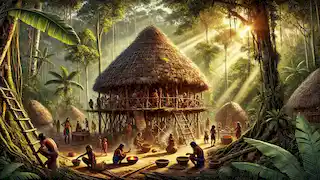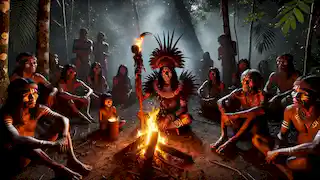The Story of the Yanomami Tribe
Reading Time: 6 min

About Story: The Story of the Yanomami Tribe is a Realistic Fiction from venezuela set in the Contemporary. This Descriptive tale explores themes of Perseverance and is suitable for All Ages. It offers Cultural insights. A journey into the heart of the Yanomami's ancient and enduring world.
The Yanomami, one of the largest indigenous tribes in South America, have lived in the lush rainforests and mountains along the Venezuela-Brazil border for thousands of years. Known for their deep connection to nature, shamanic traditions, and intricate social structures, the Yanomami’s existence stands as a testament to their resilience and adaptability. Their lives, centered around the forest and its sacredness, weave a story that is as beautiful as it is complex. This tale offers a window into the Yanomami world, shedding light on their history, way of life, and the challenges they face in the modern world. The Yanomami's roots stretch back to ancient times when their ancestors first arrived in the dense rainforests. According to their legends, the Yanomami believe they emerged from the earth and were given life by Omama, a benevolent spirit. Omama, the creator god, molded them from clay, breathing life into their bodies, thus granting them the knowledge and wisdom to survive in the jungle. Living in close-knit communities known as *shabonos*—circular communal homes made of wood, vines, and palm leaves—the Yanomami developed a lifestyle deeply intertwined with the forest. Each *shabono* housed entire families, who worked together in harmony, growing crops like bananas, cassava, and sweet potatoes, while also hunting and fishing. They believed that every element of their environment—trees, rivers, animals, and even the wind—possessed a spirit. This belief led to the concept of *hekura*, powerful spirits who could either bless or curse individuals depending on how they were treated. The Yanomami revered these spirits and often sought the guidance of shamans, who were the only ones able to communicate with the *hekura* and maintain the balance between the human world and the spirit realm. The Yanomami society is known for its unique blend of egalitarianism and communal living. There are no formal leaders or chiefs; instead, respect is earned through age, experience, wisdom, and bravery. Elders play a pivotal role in the community, passing down ancient knowledge and traditions through oral storytelling. Marriage within the tribe is arranged, often as a means of forming alliances between different families or villages. It is common for marriages to be polygamous, with men having multiple wives, although women also hold considerable influence within the household. Women are primarily responsible for tending to crops, preparing food, and taking care of children, while men handle hunting and warfare. Warfare, often seen as a means of resolving conflicts and protecting resources, is a significant aspect of Yanomami life. Inter-village disputes may arise over issues such as land, resources, or personal grievances, leading to ritualistic battles. These battles, however, follow a strict code of conduct, and while they may seem violent, they rarely result in fatalities. Instead, they serve as a way to release tension and reaffirm social bonds. Central to Yanomami society is the shaman—a figure of immense spiritual power and knowledge. Shamans serve as healers, mediators, and guides, communicating with the *hekura* spirits through elaborate rituals involving chanting, singing, and the use of hallucinogenic substances derived from the bark of the *virola* tree. The shaman’s role is critical in maintaining the tribe's health and well-being. When a member of the tribe falls ill, it is believed that a *hekura* spirit has entered their body. The shaman, using his knowledge of medicinal plants and spiritual practices, embarks on a journey into the spirit world to confront and remove the malevolent spirit, thus restoring the person's health. This connection to the spirit world also extends to daily life. Shamans play a role in ensuring successful hunts, good harvests, and protection from natural disasters. They possess a deep understanding of the rainforest's flora and fauna, making them both spiritual leaders and natural scientists. The Yanomami's isolation from the outside world ended abruptly in the 20th century. In the 1970s, gold miners known as *garimpeiros* began to invade Yanomami territory, drawn by the promise of wealth hidden beneath the soil. This incursion brought disease, violence, and environmental destruction, devastating the Yanomami communities. Malaria, introduced by the miners, spread rapidly through the tribe, decimating their population. Deforestation caused by illegal mining operations polluted the rivers, killing fish and destroying the Yanomami’s primary food source. The sacred land they had protected for generations was being stripped away, leaving them vulnerable and desperate. Faced with these threats, the Yanomami turned to outsiders for help, forming alliances with NGOs, activists, and governments. In 1992, the Brazilian government finally recognized the Yanomami's land rights, creating the Yanomami Indigenous Territory, which covers over 9.4 million hectares. However, illegal mining and logging still threaten their way of life. Today, the Yanomami tribe stands at a crossroads, balancing their ancient traditions with the encroaching pressures of the modern world. They continue to practice their customs, relying on the forest for sustenance and maintaining their shamanic practices. Yet, they face ongoing challenges from illegal mining, deforestation, and diseases introduced by outsiders. Young Yanomami are increasingly exposed to the outside world, leading to a cultural shift. While some embrace modern education and technology, others strive to preserve their traditions and language. The struggle to protect their land and identity remains at the forefront of their existence. The fight to save the rainforest and the Yanomami’s way of life has become a global issue. International organizations and activists work alongside the Yanomami to advocate for their rights, preserve their culture, and combat illegal mining. The tribe's leaders, like Davi Kopenawa Yanomami, have become outspoken advocates for indigenous rights, using their voices to shed light on the challenges faced by their people. The future of the Yanomami is uncertain, but their resilience and connection to the land give hope. Their story is a reminder of the profound knowledge and wisdom that indigenous communities hold—a knowledge that is crucial for understanding and protecting the natural world. The Yanomami's fight for survival is not just their own; it is a struggle for the preservation of one of the world's most biodiverse regions, a struggle for indigenous rights, and a struggle for humanity's connection to nature. As long as the rainforest stands, and as long as the Yanomami continue to sing their songs, dance their dances, and tell their stories, their spirit will endure. The Yanomami story is one of courage, resilience, and a profound connection to the earth. They are a people who have lived in harmony with nature for thousands of years, embodying a way of life that is increasingly rare in our modern world. Their struggle to protect their land, culture, and identity serves as a powerful reminder of the importance of preserving the world's indigenous communities and the knowledge they hold. Their tale continues, echoing through the rainforest, carried by the wind and the whispers of the *hekura* spirits. It is a story that deserves to be told, remembered, and, most importantly, respected.The Origins of the Yanomami

The Structure of Yanomami Society

The Role of the Shaman
Encounters with Outsiders

The Modern Yanomami and Their Struggles

The Future of the Yanomami
Conclusion

















